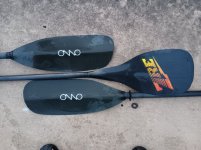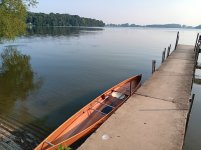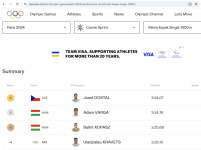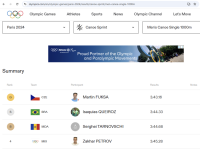I thought it would be fun to do a head to head comparison between a single and double blade to see just how much faster and more efficient, if at all, a double blade is. I decided to maintain the same target heart rate for both paddles during all testing. While heart rate is not perfect I can't think of a better way to estimate amount of exertion put forth by the paddler. This way the paddler (me) should be working the same amount with both paddles.
For my test I chose a local lake on a beautiful evening with a nearly dead calm wind. I paddled 1.1 miles down the lake before turning around and paddling back to the start for a total distance of 2.2 miles (3.54 km) for each paddle. I did the tests for single and double blade back to back on the same night.
I wore a chest strap heart rate monitor for the tests and tried to keep my heart rate at 120 bpm. For me this is a zone 2 heart rate and it's a pace I could keep for hours. It's the pace I would use if I was paddling extended distances into a head wind or if I was trying to reach camp, which was still miles away, before incoming weather. This is harder than my normal tripping pace but still easily doable for a long period of time.
After I finished the 2.2 mile runs with both paddles I then paddled .5 miles (.8 km) with each paddle with a heart rate of 100 bpm. This would be my normal tripping pace. It feels nearly effortless and takes no mental effort to maintain the pace. It's like being on autopilot. For reference 100 bpm is where I would be on a brisk walk.
My single blade paddle was a 49" ZRE medium that weighs 11.5 ounces. I paddled hit and switch.
My double blade was a 220cm Onno full carbon at 25 ounces. Onno was a small paddle manufacturer at the cutting edge of the industry around 20 years ago. This was one of the first infinitely adjustable length and feather angle paddles.

The canoe was a cedar strip Barracuda designed by John Winters. It's 17.25' long and weighs 30 pounds with a 28" max width and quite a bit of tumblehome. It's a shallow boat with only 10" of depth in the center and the seat is relatively low. It has 2" of bow rocker and 1.3" in the stern. I chose this canoe because the shallow depth and narrowness would make it easier to paddle with my relatively short 220cm double blade.
 20140802_013 by Alan, on Flickr
20140802_013 by Alan, on Flickr

I started with a 15 minute warm up paddle with the double blade to get used to it again. After some trial and error I settled on a 30 degree feather angle. Paddling with the double felt pretty good right off the bat. I haven't paddled with a double in over a decade but I feel like the mechanics were still there.
After the warmup I came to a complete stop, let my heart rate settle down and began my 2.2 mile paddle with the double blade at a 120 bpm heart rate.
Once I was finished with the double blade I again came to complete stop, rested about 2 minutes for a drink of water and to let my heart rate drop and then repeated the same course and heart rate with the single blade. Conditions were nearly dead calm.
After I finished the run with the single blade I came to a complete stop, allowed my heart rate to drop, and paddled .5 mile with the double blade at 100 bpm heart rate to simulate my all day tripping pace
After that I came to a complete stop and continued another .5 mile at 100 bpm with the single blade.
And the, to top off the night, I did a full effort 1 minute sprint with the double blade, rested for about 5 minutes, and repeated the 1 minute full effort with the single blade.
And now, finally, the results are below.
Double blade - 2.2 miles
Single blade - 2.2 miles
Double blade - .5 mile
Double blade - 1 minute all out sprint
Single blade - 1 minute all out sprint
I'll follow up with some of my thoughts and feelings in a little bit. Let me know what you think of the test criteria and the results. Was it a fair test? Was anything missed/overlooked? Were you surprised at the results?
Alan
For my test I chose a local lake on a beautiful evening with a nearly dead calm wind. I paddled 1.1 miles down the lake before turning around and paddling back to the start for a total distance of 2.2 miles (3.54 km) for each paddle. I did the tests for single and double blade back to back on the same night.
I wore a chest strap heart rate monitor for the tests and tried to keep my heart rate at 120 bpm. For me this is a zone 2 heart rate and it's a pace I could keep for hours. It's the pace I would use if I was paddling extended distances into a head wind or if I was trying to reach camp, which was still miles away, before incoming weather. This is harder than my normal tripping pace but still easily doable for a long period of time.
After I finished the 2.2 mile runs with both paddles I then paddled .5 miles (.8 km) with each paddle with a heart rate of 100 bpm. This would be my normal tripping pace. It feels nearly effortless and takes no mental effort to maintain the pace. It's like being on autopilot. For reference 100 bpm is where I would be on a brisk walk.
My single blade paddle was a 49" ZRE medium that weighs 11.5 ounces. I paddled hit and switch.
My double blade was a 220cm Onno full carbon at 25 ounces. Onno was a small paddle manufacturer at the cutting edge of the industry around 20 years ago. This was one of the first infinitely adjustable length and feather angle paddles.

The canoe was a cedar strip Barracuda designed by John Winters. It's 17.25' long and weighs 30 pounds with a 28" max width and quite a bit of tumblehome. It's a shallow boat with only 10" of depth in the center and the seat is relatively low. It has 2" of bow rocker and 1.3" in the stern. I chose this canoe because the shallow depth and narrowness would make it easier to paddle with my relatively short 220cm double blade.
 20140802_013 by Alan, on Flickr
20140802_013 by Alan, on Flickr
I started with a 15 minute warm up paddle with the double blade to get used to it again. After some trial and error I settled on a 30 degree feather angle. Paddling with the double felt pretty good right off the bat. I haven't paddled with a double in over a decade but I feel like the mechanics were still there.
After the warmup I came to a complete stop, let my heart rate settle down and began my 2.2 mile paddle with the double blade at a 120 bpm heart rate.
Once I was finished with the double blade I again came to complete stop, rested about 2 minutes for a drink of water and to let my heart rate drop and then repeated the same course and heart rate with the single blade. Conditions were nearly dead calm.
After I finished the run with the single blade I came to a complete stop, allowed my heart rate to drop, and paddled .5 mile with the double blade at 100 bpm heart rate to simulate my all day tripping pace
After that I came to a complete stop and continued another .5 mile at 100 bpm with the single blade.
And the, to top off the night, I did a full effort 1 minute sprint with the double blade, rested for about 5 minutes, and repeated the 1 minute full effort with the single blade.
And now, finally, the results are below.
Double blade - 2.2 miles
- Average heart rate - 120 bpm
- Average speed - 4.7 mph (7.6 kph)
- Time - 28:14
Single blade - 2.2 miles
- Average heart rate - 119 bpm
- Average speed - 5 mph (8 kph)
- Time - 26:27
Double blade - .5 mile
- Average heart rate - 99
- Average speed - 3.9 mph (6.3 kph)
- Time - 7:36
- Average heart rate - 99
- Average speed - 4.1 mph (6.6 kph)
- Time - 7:15
Double blade - 1 minute all out sprint
- Max speed - 6.7 mph (10.8 kph)
- Average speed - 6.4 mph (10.3 kph)
- Max heart rate - 164 bpm
Single blade - 1 minute all out sprint
- Max speed - 6.6 mph (10.6 kph)
- Average speed - 6.4 mph (10.3 kph)
- Max heart rate - 169 bpm
I'll follow up with some of my thoughts and feelings in a little bit. Let me know what you think of the test criteria and the results. Was it a fair test? Was anything missed/overlooked? Were you surprised at the results?
Alan


